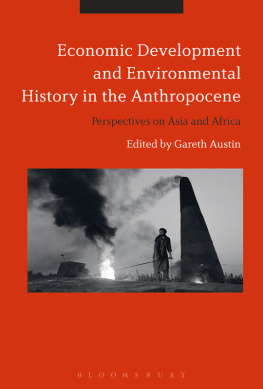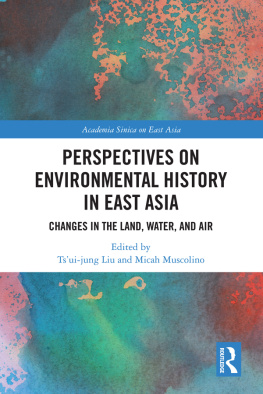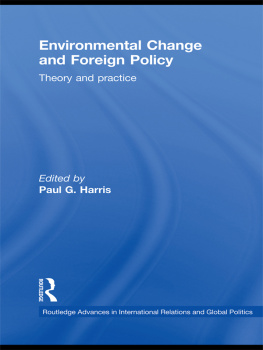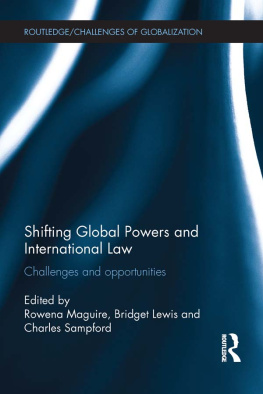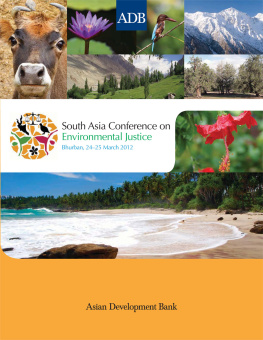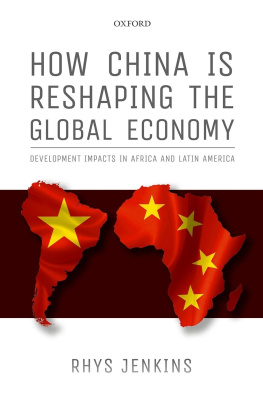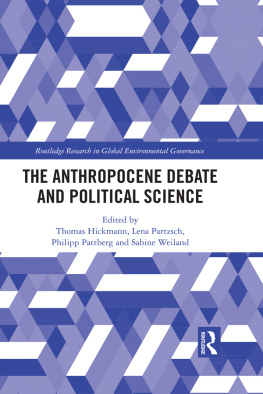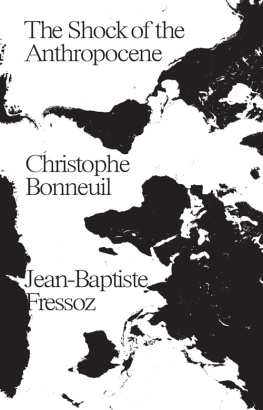Economic Development and
Environmental History in
the Anthropocene
Economic Development and
Environmental History in
the Anthropocene
Perspectives on Asia and Africa
Edited by Gareth Austin
Bloomsbury Academic
An imprint of Bloomsbury Publishing Plc

This book is dedicated to the memory of Peter Boomgaard, 19462017
This book stemmed from a belief that, in a time when open-minded citizens around the globe have become more aware than ever of the often unstable interactions between human activity and our physical environment, economic historians and environmental historians, together with colleagues from economics and geography, need to work more closely together in research and teaching. The project was born in Geneva, at the Graduate Institute of International and Development Studies, with a small conference on 2627 September 2014, generously funded by the Pierre du Bois Foundation for Current History. I am delighted to pay tribute to the support of the board of the Foundation, and especially Irina du Bois, who invited the proposal for the conference, assisted with the arrangements and attended both the conference itself and the accompanying public forum. Valrie van Daeniken and Gabriel Geisler Mesevage of the Institutes Department of International History provided excellent organizational support. While most of the chapters were first presented at that conference, I am particularly grateful to three conference participants who, seeing the way our collective discussions had developed, very kindly decided to write new and very different essays for the book: Tirthankar Roy, Kaoru Sugihara and Julia Adeney Thomas. I am equally grateful to Peter Boomgaard and Emily Osborn, who gracefully agreed to join the project after the conference. Indeed, I am extremely appreciative of the whole team of authors, who contributed so much time in a very self-disciplined manner, and of Bloomsbury Academic, in the persons of Emma Goode and initially also Claire Lipscomb, who encouraged us throughout. I also thank the publishers anonymous reviewers, who not only made the right recommendation but also provided extremely shrewd and constructive criticism that has helped us improve the cohesion and content of the book. Finally, I pay tribute to my wife, Pip Austin, who did much of the initial copy-editing and the majority of the indexing, and did her best to keep the editor relatively sane.
Gareth Austin
Geneva and Cambridge, December 2016
Gareth Austin
At the beginning of this century the Dutch Nobel-prize-winning chemist Paul Crutzen proposed to assign the term Anthropocene to the present, in many ways human-dominated, geological epoch, and to date its beginning to the British industrial revolution, starting in the latter part of the eighteenth century (Crutzen 2002; also Crutzen and Stoermer 2001). He highlighted the large and growing rate of burning of fossil fuels (following James Watts improvement of the steam engine) and the resulting emission of greenhouse gases, and also emphasized deforestation and the accelerated conversion of land to agricultural and urban uses. Other natural scientists insist that it was only with the radioactivity from open-air nuclear tests that our species became an agent of geological change. That would place the origin of the epoch at the beginning of the 1950s, which for Crutzen and co-authors was just after the beginning (194550) of what they called the Great Acceleration, that period within the Anthropocene when every component of the human impact on the rest of nature intensified, including multiple extinctions of other species (Steffen, Crutzen and McNeill 2007). The Anthropocene Working Group (AWG), reporting to the International Geological Congress in Cape Town in August 2016, endorsed the idea of a 194550 beginning for the Anthropocene, featuring not only nuclear explosions but also the proliferation of domesticated chickens and plastic pollution (for an example of the latter, see Osborns chapter).
The process that accelerated from 194550, however, clearly had chronologically deeper roots. The end of the last ice age inaugurated the Holocene, an epoch in which the temperature and rainfall conditions over much of the planet made possible both the original (Neolithic) agricultural revolution and the industrial revolution. The latter was a watershed in human history, in that there now seems little doubt that, in a vicious dialectic, the worldwide albeit not universal spread of industrialization has undermined some of the environmental foundations of continuing economic development. For the already developed economies, a continuation of present
Ironically, the further economic advance of poorer countries is at risk both from the predicted effects of global warming and from the measures desperately needed to mitigate it. Rising sea levels, resulting from large-scale melting of polar ice, threaten to flood low-lying cities and countries, especially in economies with very limited resources for protective measures. The reduced rainfall predicted for certain regions would imperil crop yields and extend deserts. Meanwhile, different parts of the developing world have specific resource problems, such as water shortages and accelerated depletion of soil nutrients which, in the absence of global warming, could be handled by the acquisition and application of additional inputs in the form of desalinated sea water and chemical fertilizers. Both the latter, however, are fossil fuel intensive to produce; and fertilizers themselves require water. Thus major reductions in fossil fuel use are difficult to combine with solutions to the often more immediate and relatively localized resource constraints. Again, it is likely that any serious global resolution to reduce consumption of fossil fuels would significantly reduce the export earnings of oil producers in middle-income and poor countries as well as rich ones.
This book combines new research and critical overviews that explore the interactions between human populations and their physical environments, in the process of economic development and in the context of the Anthropocene. We focus on four world regions in which industrialization and self-sustained (or so it seemed) economic growth began later than in the West: East Asia, Southeast Asia, South Asia and Sub-Saharan Africa. So far, it is only some of the East Asian countries Japan long since, more recently Hong Kong, Taiwan and South Korea and Singapore that have caught up the West in income per head. But much of the rest of Southeast Asia, plus India and, most dramatically, China, have significantly narrowed the gap over the last thirty-five years or so. In Sub-Saharan Africa, as a whole, economic growth seems to have outpaced population growth by about 2 per cent since 1995, when the latest primary commodity-led boom in African history began. Despite some promising signs, it remains to be seen whether this can lead on to industrialization: while growing in absolute terms, manufacturing as a share of GDP actually slipped between 1980 and 2010, to 11 or 12 per cent (Austin, Frankema and Jerven 2017). The four regions have in common that most of their component countries were Western (mainly European) colonies in the nineteenth and early twentieth centuries, or were subject to unequal treaties imposed by Western imperial powers in the nineteenth century. Together, these regions are estimated to have 72 per cent of the worlds population, 5 billion out of 7 billion. In mid-2016 this comprised nearly 1,620 million in East Asia, over 1,850 million in South Asia, over 970 million in Sub-Saharan Africa and over 630 million in Southeast Asia (Population Reference Bureau 2016).
The following chapters consider human responses, at regional and local levels, to economic and environmental challenges and opportunities that arose at a range of scales. At global level, besides climate change, there are international flows of knowledge, commodities and capital, which may offer producers in one area the chance to import some sort of solution to their particular energy or other resource needs, importations which may be adapted to local needs with varying degrees of success. Interactions between the global and the regional or local must be seen in the context of the specific approaches, often reinforced by past experiences and choices, with which local populations and states had reacted to their own environments.
Next page
